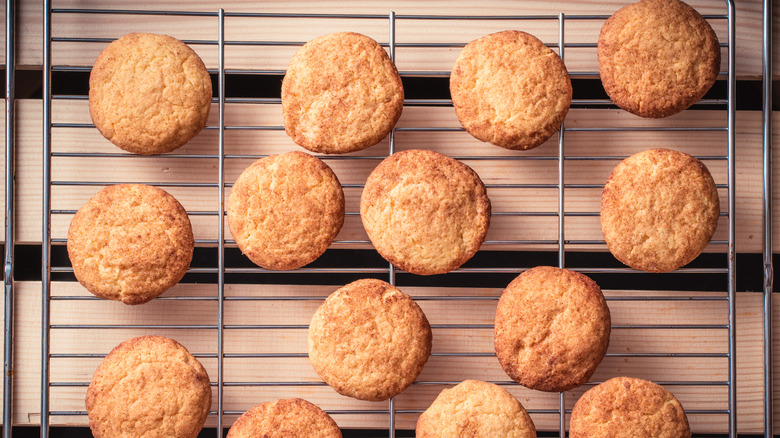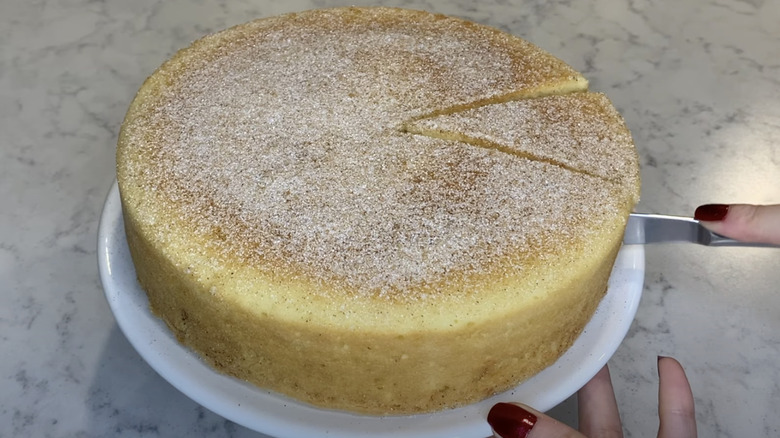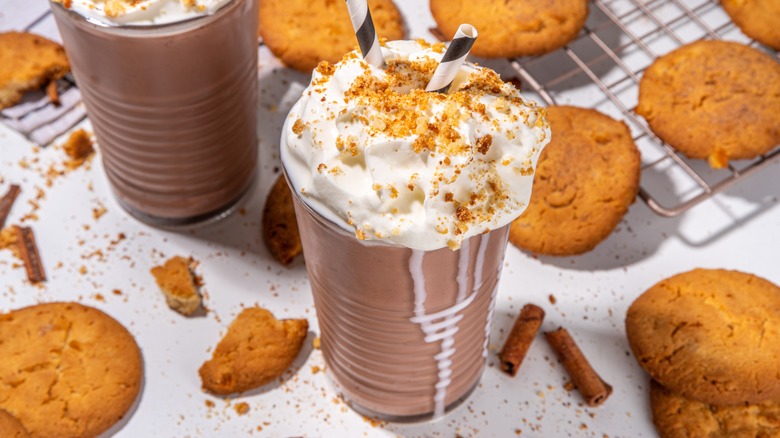The Whimsical Origins Of Snickerdoodle Cookies
Snickerdoodles are as fun to say as they are to eat. They may not be the most exciting-looking cookies, lacking bright colors, pillowy frostings, or chocolate chips, but their flavor, while simple, is unmatched. Butter, sugar, and cinnamon flavors burst from these pleasantly chewy, moist cookies that have become an American classic. For those not in the know, one might assume the cookie has something to do with Snickers bars but, alas, snickerdoodles lack the caramel, chocolate, peanuts, and nougat of the popular Halloween candy. The name is said by some to be an interpretation of the German word "schneckennudeln," which roughly translates to "crinkly cookies."
Because of this, some people believe snickerdoodles to be of German origin, but they were actually likely first created in New England. The word "snickerdoodle" itself may be a completely nonsensical word, created to be playful and fun. And really, isn't that what making and eating cookies is all about? Still, the Germanic origin theory does make sense when you consider a particular German dessert called "schneckennudeln," meaning "snail noodle," essentially a type of cinnamon roll, which could also explain the generous amount of cinnamon in snickerdoodles. Furthermore, it is believed that the original New England snickerdoodle wasn't a traditional cookie at all, but rather a type of coffee cake.
The cake that became a cookie
The snipdoodle, also known as snickerdoodle cake, is a vintage recipe that has been around since the late 1800s. It's believed that the Pennsylvania Dutch (who are not Dutch at all, but rather German and Swiss) population gave the cake its name. A tender, moist coffee cake, it is sprinkled with a layer of cinnamon and sugar on top. Early printed recipes from 1889 and 1891 describe very specific methods for baking a cake, not cookies, but by 1895, the "AA Cookbook" contained a similar recipe for snickerdoodles, this one being a type of drop cookie.
By the time the early 20th century rolled around, recipes for both snipdoodles and snickerdoodles were plentiful, with people understanding that the former was specifically a type of cake, while the latter were cookies. But this wasn't the end of the metamorphosis that the tasty cookie would undergo. The original recipes and those throughout the 1920s contained butter as the primary fat. Once the Great Depression and World War II came about, butter became a sparse and expensive ingredient, so many began substituting shortening, which you'll still find in many modern recipes.
Is it just a sugar cookie with cinnamon?
Despite the fact that snickerdoodles look like round sugar cookies with a dusting of cinnamon sugar on top, and that they share several ingredients, the two are distinct, particularly by the addition of cream of tartar in snickerdoodles. This ingredient, perhaps most known for stabilizing egg whites, works to prevent sugar from crystallizing, contributing to snickerdoodles' wonderful, pillowy softness (as opposed to crispness). It also imparts two unmistakable elements that these cookies are known for: a tangy flavor, and satisfying chewiness. It is sometimes said that using shortening instead of butter achieves a similar texture to the cookie as cream of tartar does, but omitting the powdery ingredient will also remove the light sourness that people love so much.
There are several ways to jazz up traditional snickerdoodles, like adding pureed pumpkin, instant coffee, using browned butter, substituting eggnog for milk, and adding dried fruit like cranberries. These cookies have become so beloved by many that the word is no longer just equated with a cookie; "snickerdoodle" has become a flavor that you can find in lattes, milkshakes, cakes, and even snack foods like almonds, popcorn, and sandwich cookies.



